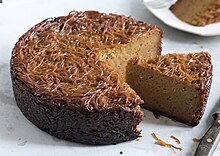Noodle kugel
The name of the dish comes from the Yiddish word kugel meaning 'sphere, globe, ball'; thus the Yiddish name likely originated as a reference to the round balls of dough that were placed in the center of the cholent, a traditional Shabbat stew, to cook alongside it and absorb its flavors for its later use as a side dish.[1] Due to differences among Yiddish dialects,[2] Litvaks (Jews whose families formerly resided in Lithuania, northeastern Poland and northern Russia) pronounce the name of the dish as kugel, while Galitzianers (Jews whose families formerly resided in southeastern Poland and western Ukraine) pronounce it as kigel.[3] The Lithuanian Jews (also known as Litvaks) are known for their preference for dishes seasoned with a fair amount of salt and pepper and are said to be the progenitors of many of the savory noodle kugels, while the Polish Jews (those from southeastern Poland also known as Galitzianers) are known for their preference for sweet dishes and are said to be progenitors of many of the sweet noodle kugels.[1] A cornflake topping for sweet noodle kugels, typically for those containing dairy ingredients and not pareve, was first popularized in the early 20th century in the United States as the confluence of American and Ashkenazi Jewish cuisine.This topping is prepared by pulverizing cornflakes either by hand or with a food processor, and then mixing them with sugar, cinnamon and melted butter.
casseroleJewishRussiaEastern EuropeIsraelUnited StatesFranceCanadaUnited KingdomAustraliaArgentinaSouth AfricaJewish diasporaAshkenazi JewsLokshenraisinsdried fruitparevecottage cheesesour creamcream cheesecooking oilmargarineapplesaucecornflakesstreuselgraham crackersKugel YerushalmiAshkenazi JewishShabbatJewish holidaysYiddishcholentYiddish dialectsLitvaksLithuaniaPolandnorthern RussiaGalitzianerswestern Ukrainecasserole dishLithuanian JewsPolish JewspogromsAmericaAmerican Jewish cuisineJerusalem kugelJewish delisGerman Jewsbreadcrumbsmacaroni and cheeseAmericanAshkenaziJewish cuisineCuisine of IsraelPotato kugelList of casserole dishesPotatonikHaaretzThe New York TimesJewish prayerYedid NefeshLekhah DodiShalom AleichemKiddushZemirotBaqashotTorah readingWeekly Torah portionShnayim mikra ve-echad targumMaftirHaftarahShabbat mealsSeudah shlishitTriennial cycleTorah studyKosher wineChallahBrisket (Jewish dish)Chopped liverGefilte fishHelzelVorschmackKubanehJachnunSabichYapchikShabbat candlesChallah coverMelakhaBiblical mileBiblical SabbathDrivingElectricityEruv tavshilinEruv techuminFood preparationMuktzehRabbinic prohibitionsShabbat (Talmud)Shabbos goyShinuyShomer ShabbatKosherSwitchZomet InstituteShabbat elevatorShabbat lampSabbath modeShabbat pedestrian crossingSpecial ShabbatShabbatonEve of Passover on ShabbatMotza'ei ShabbatKiddush levanaHavdalahMelaveh MalkahList of Shabbat topicsAncient Israelite cuisine1902 kosher meat boycottJewish-American patronage of Chinese restaurantsEthiopianIsraeliMizrahiBukharanMountain JewishMoroccan
